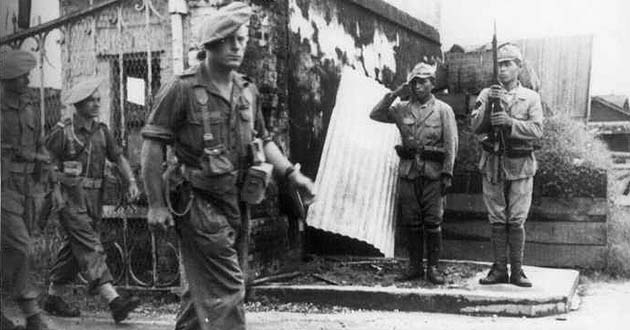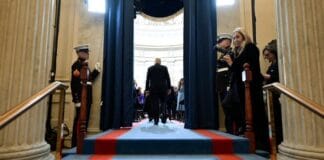When France returned as a colonial power to Vietnam in 1945, the Vietminh were determined to hold back social revolution, writes Mark Goudkamp
The events surrounding the 1945 Saigon insurrection against imperialist French troops re-occupying Vietnam at the end of the Second World War have been overshadowed by the US war in Vietnam two decades later.
But Vietnam in the 1930s and 1940s was one of the few places at the time where Trotskyism played a central role in the labour movement.
Two groups, La Lutte (Struggle) and the League of International Communists, had significant influence, particularly in Saigon and its twin city Cholon. During the uprising, they played a leading role in setting up scores of Popular Action Committees.
A small group of Vietnamese students in Paris were convinced by the writings of the Russian revolutionary, Leon Trotsky. Stalin’s rise to power in Russia had crushed the revolution and seen the adoption of socialism in one country, as Stalin sought alliances with imperialist powers like Britain and France. This also led Stalin to a “stages theory” of revolution, which held that underdeveloped countries like China and Vietnam could only achieve nationalist revolutions that brought local capitalists to power. The lessons of the Russian revolution of 1917, where a democratic revolution grew over into a socialist revolution bringing workers and peasants to power, were ignored.
In China in the 1920s, Stalin’s approach proved disastrous, as the Communist Party held back workers’ struggles and allowed a nationalist party to take power and unleash vicious repression against workers.
The Vietnamese Trotskyists sought to develop a Marxist strategy in opposition to the Indochinese Communist Party that was led by Ho Chi Minh and loyal to Stalin’s Russia.
French colonial rule
French colonial rule in Indochina was brutal, but it also generated massive resistance.
In 1930, rebellious soldiers in the north and peasants across Vietnam staged an armed uprising. The French responded by destroying the villages—bombarding some, while security police reduced others to ashes.
The Vietnamese Trotskyist Ngo Van Xuyet recalled in his autobiography In the Crossfire: “Between May 1930 and June 1931, I counted newspaper reports of no less than 120 peasant marches and more than 20 strikes in Cochinchina [the southern part of the French Vietnam].”
From 1934, a coalition of revolutionaries (Stalinists, Trotskyists, and anarchists) began to produce a legal French-language newspaper, La Lutte, and to stand in Saigon City Council elections. This alliance, which struggled against both the colonial regime and the pro-French bourgeois Constitutionalist Party, lasted nearly three years. Ngo recalls how meetings were, “filled to overflowing with the common people of Saigon and infiltrated by Sûreté cops [the secret police]”, with speeches using taboo words like “union”, “capitalist”, “proletarian”, “strike” and “class struggle”.
But in 1935 the “Franco-Soviet Mutual Assistance Pact” was signed, and the Indochinese Communist Party, following Stalin, put Russian foreign policy before revolution, and dutifully supported the French empire.
Faced with this turn by the Communist Party, Ngo Van and other comrades split from La Lutte to form the League of Internationalist Communists (LIC). As Ngo writes: “We feared that the victory of Vietnamese nationalism over French imperialism would simply mean the rise of an indigenous bourgeoisie, and that the desperate condition of the exploited workers and peasants would remain the same as ever.”
But the Trotskyists’ influence was growing. They organised a large secret meeting with delegates from 40 factories and workshops in Saigon-Cholon to set up the Syndicalist Workers Federation.
The police issued a statement of alarm, “The workers are supporting the Trotskyist party more than the Indochinese Communist Party.”
In Saigon council elections in 1939, with the Second World War looming, the Trotskyists humiliated both the Stalinised Communist Party and the Vietnamese bourgeois parties.
The Communist Party had campaigned for democratic reforms but supported the French government’s conscription of 20,000 extra soldiers to defend their empire in the coming war and a new armaments tax.
The Trotskyists denounced all compromise with the French colonial regime and argued for a “united front of workers and peasants” against war.
They wrote to Trotsky, now living in Mexico after being expelled from Russia by Stalin, that, “despite the shameful coalition of the bourgeoisie of all types and the Stalinists we have won a stunning victory.” Trotsky was overjoyed.
World War II
When the war broke out, the French authorities ruthlessly repressed both the Trotskyists and Communists. While the Japanese army swept through Asia in the early 1940s, it was only in March 1945, as they faced defeat by the Allies, that the Japanese imprisoned the French authorities and took direct control of Vietnam, trying to present themselves as liberators from colonial rule.
Ho Chi Minh and the Communist Party created the Vietminh (Vietnam Independence League). Its program excluded any reference to class struggle and agrarian revolution. Instead, its aim was: “To expel the French and Japanese fascists and to establish the complete independence of Vietnam, in alliance with the democracies.”
The new Japanese Governor launched the JAG (Vanguard Youth) to try to tap Vietnamese nationalist sentiment and maintain control. “In the cities, the [JAG] movement soon became the de facto power in every factory, every office, every workshop and every school… It was the same in the countryside, from the main county towns to the smallest hamlet,” Ngo wrote.
When the Japanese army surrendered to the Allies on 15 August, it left a power vacuum. Vietminh troops entered Hanoi and took control of northern Vietnam.
But workers did not simply want national independence. Near Hanoi 30,000 coal miners elected workers’ councils to manage production, taking control of public services, the railways and the telegraph system. “In this working-class ‘Commune’, life was organized with no bosses and no cops”, wrote Ngo.
However, the Vietminh, in line with the Stalinist “stages theory” was determined to limit the struggle and crushed any efforts towards workers’ revolution. They looked to deal with Britain and the US, boasting: “[We have] collaborated closely with the Allies in the fight against the French and the Japanese. We will thus be in a good position to negotiate [independence].”
Most of the nationalist groups now aligned themselves with them. The Vietminh announced that they were forming an interim government.
The Vietminh urged people to co-operate with the Allies, declaring, “Every building, public or private, should display the national flag of Vietnam, surrounded by the flags of the British, the Americans, the Russians and the Chinese.”
The Vietminh denounced the Trotskyists who were organising the workers, “A certain number of people who are traitors to the Fatherland. We must punish the gangs who are stirring up trouble.”
In the north, Ho Chi Minh had already eliminated his political opponents. Now the Trotskyists in the LIC organised to resist in the south. “We put out a leaflet and distributed it in the Central Marketplace, calling on the population to arm themselves, to organize themselves in people’s committees and to set up people’s militias…
“In Saigon, large numbers of people’s committees arose spontaneously as organizations of local administration… Embryonic people’s councils were springing up everywhere”.
In some provinces peasants spontaneously took possession of the land. “‘The land to those who work it’ had once been a Communist party slogan, but now, shamefully, in the name of independence, party militants tried to restrain the peasant. The peasants responded by threatening to lynch them.”
Although the Communist-led Vietminh cravenly welcomed British General Gracey’s arrival in Saigon, he quickly ejected their interim government. The Vietminh urged the population (along with its armed forces) to disperse into the countryside and to, “remain calm, as the de facto government hopes to obtain negotiations”.
But Gracey freed and re-armed French soldiers, who unleashed a reign of terror against the local population.
The city centre fell to the French, supported by British forces. But the outskirts of the city and the suburbs, where most of the poor lived, was controlled by a coalition of insurgents (including some Vietminh). Saigon was surrounded. What happened in the city was now crucial.
In Saigon, workers at the Go Vap tram workshops, influenced by the Trotskyists, broke with the Vietminh labour union and formed their own workers militia.
Under fire from two sides
However, the Trotskyists were under fire from two sides—Anglo-French troops and the Stalinist Vietminh. It was the latter who murdered most of their leaders.
Ta Thu Thau (a very popular Trotskyist who had been elected three times to the local council) was captured and murdered by the Vietminh on his way back from the North.
A week later, the Vietminh sent police against the Tan Dinh people’s committee in Saigon where the Trotskyists were very active. Weapons were seized and 30 delegates imprisoned.
French forces were failing to break out of Saigon. But on 3 October, the Vietminh called for insurgents to only fight the French. This “appalling and deadly folly”, as Ngo describes it, allowed British Gurkhas and Japanese troops to pass freely through insurgent controlled areas and re-take strategic positions, enabling the French to break the resistance elsewhere.
Within months, masses of French troops had re-established colonial rule.
Ngo fled for France, one of the few Trotskyists to survive the Vietnminh’s massacres. He later wrote that: “Of all those who had taken part in the revolutionary opposition movement and who had remained in the country, barely a one survived.”
The Saigon uprising exposed the counter-revolutionary policy of Stalinism on a scale no less significant than the crushing of the Chinese Revolution of 1925-27 and the Spanish Revolution of 1936-39.
The Vietminh fought a guerrilla war against the French, defeating them in 1954. But Vietnam was then divided with Ho Chi Minh controlling the North while a US-supported dictatorship controlled the south.
A heroic war to unite Vietnam finally defeated US imperialism in 1975. But the Communist Party, after crushing the hopes of workers’ revolution in 1945, simply set about building an independent Vietnamese state capitalism. It was the Trotskyists, and the insurgent workers’ struggles they took part in, that showed the possibility of the struggle against imperialism to build genuine socialism from below.






